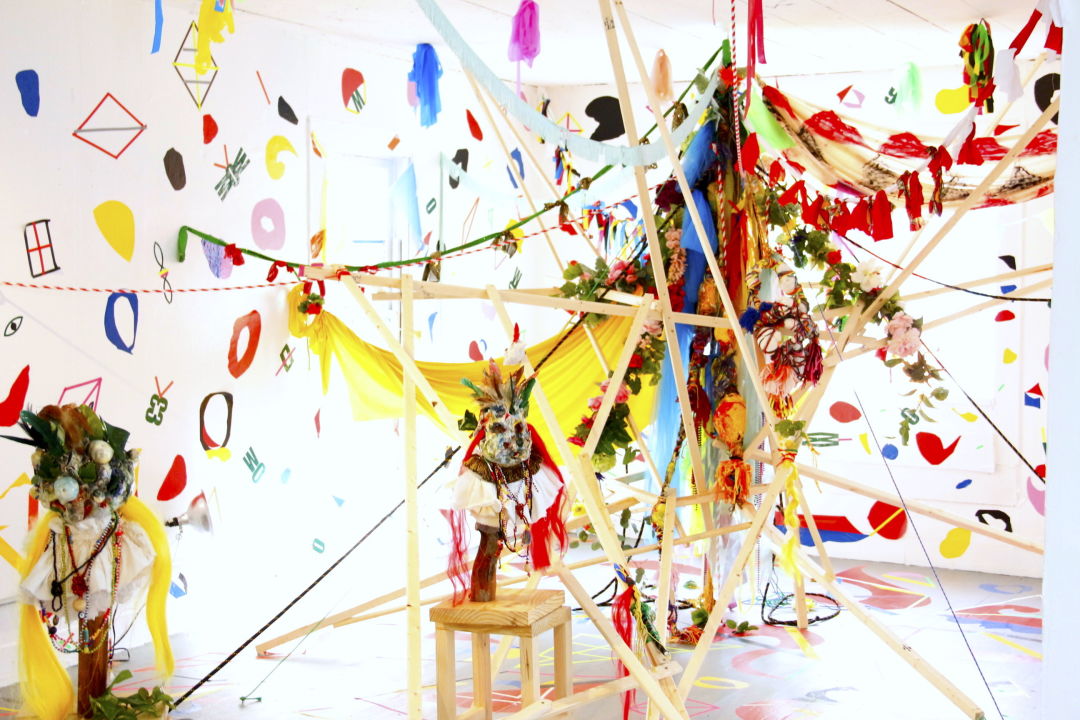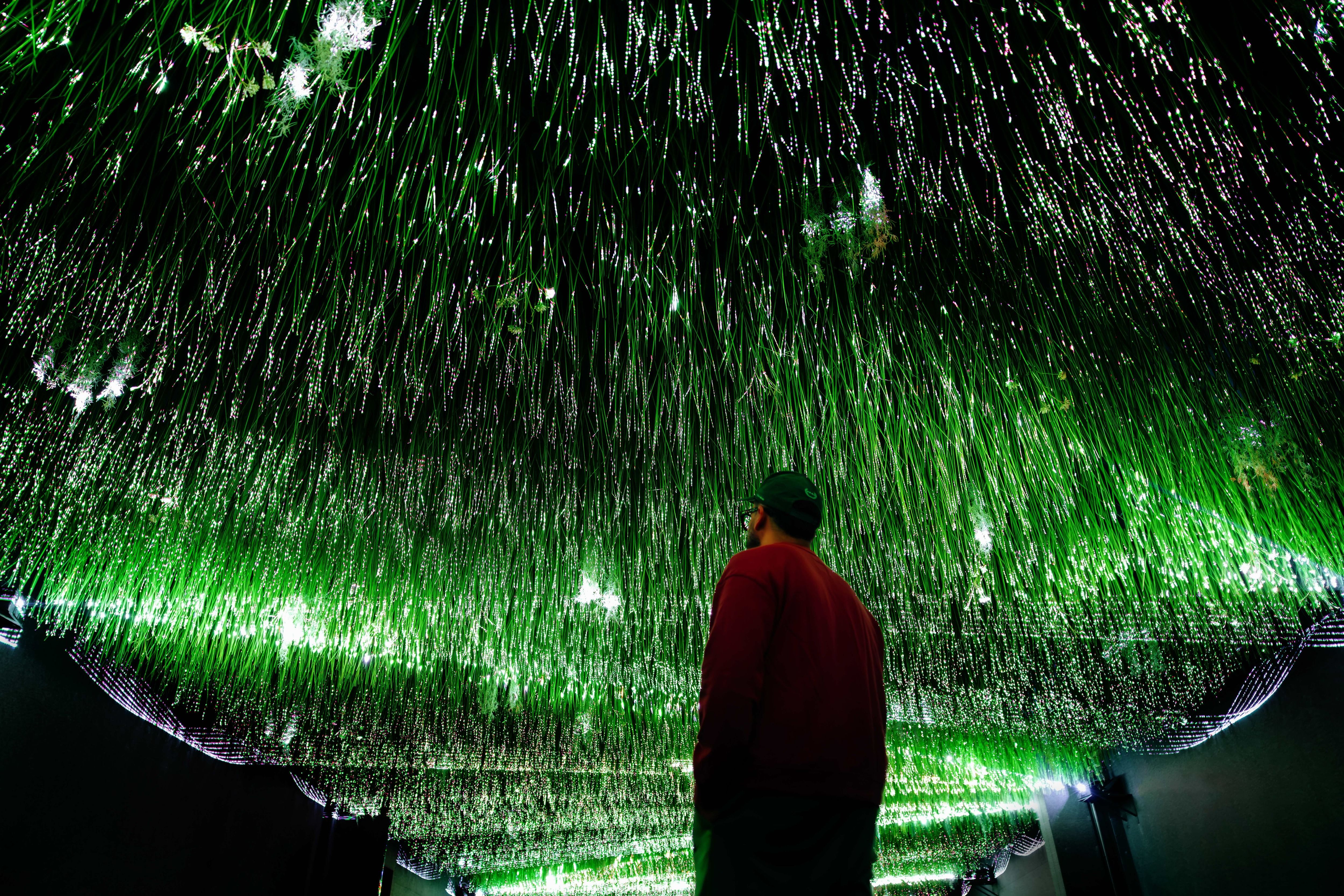Exploring Shadows and Light at Project Row Houses

Written on Skin and Sacred Gestures by Charo Oquet.
Image: william cordova
"This piece has a lot to do with healing through joy and through hope," says Charo Oquet.
The Dominican artist is standing in the middle of her installation inside 2515 Holman Street, one of the Project Row Houses buildings. The work, titled Written on Skin and Sacred Gestures, incorporates planks of wood, glass bottles filled with dyed water, large scraps of colorful fabric, and talisman-like sculptures, all climbing up a path into the middle of the room. The installation does evoke a feeling of joy, or maybe a feeling of accomplishment, as though one has scaled a large mountain.
Oquet joins the latest iteration of Project Row House’s Artists Rounds, a biannual collaborative project that uses art to create conversations about culture, history, and community. Round 49 is called Penumbras: Sacred Geometries and is inspired by the works of artist Bob Powell, who participated in PRH’s third artist round, and Dr. John Biggers, the legendary Houston artist and art teacher.
Sacred geometry refers to the idea that certain mathematical or geometric patterns underly every aspect of nature (think: Golden Ratio). A penumbra is the outer, partially-shaded part of a shadow. Thematically, penumbras can refer to something partially obscured, and in the context of sacred geometry, those unseen forces could potentially influence a lot of the world around us.
On a more literal level, Round 49 is about “the intersection of the African and Latin American diaspora,” says Co-Curator Ryan Dennis. “It’s about making these connections—to the South, to the diaspora and the Caribbean.”
Round 49 was curated in connection with the Latino Art Now! Conference, which will take place April 4–6 at UH. In addition, the exhibit will include an immersive live performance, Sitting on A Man's Head, on April 11 and 12 as part of the 2019 CounterCurrent Festival. Dennis says the works in Round 49 don't necessarily deal with the theme in obvious ways. “We wanted people to dig deeper,” she says.
Take Oquet’s installation. “I’ve worked with wood and towers since, well, since the fall of the Twin Towers,” Oquet says. “The wood is like the skeleton—it’s the part you don’t see.” Her work is about cultivating joy in the midst of disaster. “In Dominican culture, our way of dealing with our problems is we dance it out, we party it out. That’s what I mean by radical hope.”
Though many of the artists in Round 49 are based in the Miami area, they all have connections to PRH, according to co-curator william cordova. Yanira Collado and Onajide Shabaka, for example, both collaborated with PRH and cordova in 2015. “I got to know these artists through the years, and I tend to highlight artists that are underrepresented,” he says. cordova himself has contributed a project that looks at the lesser-known multicultural histories of radical groups like The Black Panthers and the Young Lords.
For this round, Collado has incorporated ephemeral items, including used clothing and objects she’s picked up on her walks through the Third Ward, into structures reminiscent of walls and cabinets. “These are all textiles that have a history,” she says. “They’re a symbol of going forward with the past.”
Shabaka wanted to explore the role of Texas in the Underground Railroad, as slaves made their way to Mexico and freedom. His work echos the constellations those travelers followed as they navigated South. His installation is quiet and welcoming in a way that is totally different than Oquet’s exuberant house. “I wanted to create a meditative space,” Shabaka says.
Aramis O’Reilly, a visual art professor at Miami-Dade College, is inspired by the shifting nature of time. His installation, Forms in the Garden, makes use of photographs taken by his wife, Pierina Guido, which depict natural objects like trees and clouds. O’Reilly then responds to those photographs with a collage of colorful papers and other irreverent items, like circular reinforcement stickers for looseleaf paper.
O’Reilly says he’s interested in the idea of an artist as a vessel for some greater unseen force, and that responding to his wife’s work allows him to tap into that force. The garden theme comes into play, he said, as he contemplates “the patterns and structure that nature and the physical world take on with exuberance” — in spite of mankind’s attempts to intervene. “Photos are interesting because they are images of objects that aren’t actually here,” he says. “They represent an intangible part of time than the one we’re experiencing right now.”
O’Reilly was already exploring this theme in his work when he encountered Plato's allegory of the cave. In the story, a group of prisoners see a shadow on the wall in front of them, not knowing the shadow is coming from people behind them. It’s the shadow, not the source of the shadow, that the prisoners respond to.
“All objects reflect light,” O’Reilly says. “It’s the light we’re responding to. So those objects are a vehicle for something else."
Reading Plato felt like a validation of what he was already working on. How did he stumble across those writings? Perhaps he was guided by the hand of some unseen, outside force.
Penumbras: Sacred Geometries runs through June 9, 2019 at Project Row Houses. More info at projectrowhouses.org.




